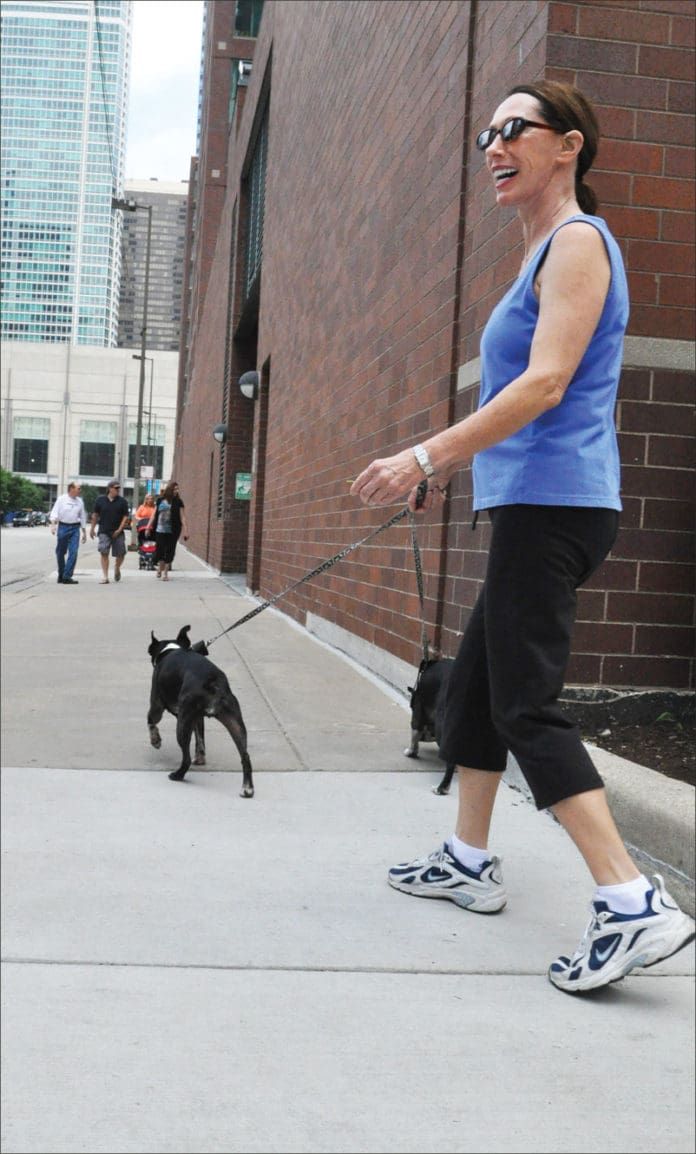I confess: I have a hard time fitting in enough exercise for myself and my dog. Nothing earth-shattering about this admission; I think not getting enough exercise is a universal condition. Even though my dog and I walk daily, life and age just keep creeping up, making it harder and harder for me to stay fit. And, my high-energy herding dog seems to always need just a little more in the way of activity than I have time and energy to provide.
You can imagine how I feel if I try to sneak out of the house and head off to the gym without her. That look! You probably know the one: perked up ears, soft eyes, and the head tilt that asks, “Can’t I please come?” Of course, just heading out for a regular walk isn’t really the answer either; dog walks are not always the best exercise. On our daily walks, my dog enjoys sniffing and checking p-mail. We both stop and talk to neighbors. I admire the gardens while she checks out the squirrels. She probably fares a little better than I do exercise-wise because she inevitably talks me into chucking the ball at the park or snapping the leash off for a little wave-chasing at the beach. But both of us could use more.
So when I recently heard about a movement to turn dog walks into a more gym-like workout, I thought, what a great idea!
Dogs Make Great Personal Trainers!
This is not news for those who hike or run with their dogs. But you don’t have to be a serious athlete to gain the benefit of dog as personal trainer. Dogs can be terrific fitness partners for all activity levels. They seldom cancel last minute, and are not likely to let you cancel either. Dogs thrive on routine, so if you get distracted or procrastinate, your dog will likely remind you when it is time to get moving.
For both of you, working out together may bring significant health benefits such as a lower risk of heart disease, diabetes, arthritis, and other chronic conditions. You may sleep better, your weight may improve, and your stress levels may go down. The extra activity and mental stimulation may also help your dog relax and behave better, too.
Since you won’t be splitting your energy between the gym and your dog, workout walks may lead to more together time, more activity overall for your dog, and greater opportunities for practicing basic skills.
Get your Dog Involved in Workouts
One of the great things about the workout walk is that it really doesn’t take a lot of training for your dog. However, there are a few basics that will help you get the most from your exercise time together.
If your dog has enjoyed leisurely walks, complete with lots of stopping and sniffing, you can insure the success of your workout by taking the time to teach your dog that the workout walk is a different activity. It may take your dog a few sessions to learn the new rules. Take your time at first and focus on your dog’s skills (instead of on the exercising) and you will both get more out of the workout down the line.
Consider also that some of your walks may be workout walks, but other walks may remain casual, full of sniffing and exploring. How will your dog know which is which?
In our household, we have found it helpful to use a cue to let our dog know which type of walk is afoot. We may take a sniffing and potty walk in the morning, and a workout walk in the afternoon, and some of our walks are a combo of both. If we say, “Your choice!” and head out in a leisurely fashion, our dog knows she can weigh in on which path we follow and sniff and explore to her heart’s content. If we say, “Let’s walk!” and step off at a fast stride and with purpose, she knows we will be moving quickly, and the sniffing will need to wait until we take a break. By cueing our dog at the start of the walk, or when we are switching walking modes within a walk, we help her understand what is expected.

Learn to Move Together
A great skill for a dog to attain for a workout walk is the ability to move in tandem with you. When we are out for a stroll with our dogs, a lot of us are pretty happy with them walking in front, behind, or even off to the side as long as the leash is loose and they are not pulling us off our feet. However, when you are walking, jogging, or running with your dog for a workout, having him walk close to you in the “shoulder at knee” heel position can be a great advantage. Your dog can see where you are going and can move, turn, or change speeds more easily. The heel position sets you up to move as one. It also helps reduce the possibility of tripping over each other.
If your dog doesn’t know this behavior, you will need to teach it to him before you head out on your exercise walks. Start in a quiet environment where your dog will not be tempted by great smells or other distractions. Teach your dog where you would like him to be by stepping out ahead of your dog and encouraging him to follow. As your dog catches up, click and treat when his shoulder is in line with your leg. Then, while he is focused on the treat, quickly step off again and repeat. Once your dog gets the idea, add in a few steps before you click and treat.
Expect that your dog will have a harder time once you start to walk together away from your low distraction environment. Great smells on a walk, for example, may be some of the toughest distractions your dog will have to deal with. Try keeping the leash a little shorter than you might normally to prevent your dog digging into a great smell or moving out ahead. But if your dog does move ahead of you, simply back up or turn the other direction (with a very gentle pressure on the leash) until your dog returns to your side, then click and treat and move forward again. If your dog lags behind, make a fun or exciting noise to get his attention, then click and treat when he catches up.
Once your dog has the idea, try using the great smells on a walk as the reward. Ask your dog to “Let’s walk,” and move together quickly (travel just a few feet for a novice dogs and as much as a few blocks for experienced dogs). Then give the cue to “Go sniff!” as a reward.
Tip:If your dog doesn’t have a lot of experience moving quickly or running with you, he or she may, at first, get overexcited and jump up or playfully grab at you when you move quickly – especially young dogs and herding dogs! To eliminate this problem from the start, at first take just one or two quick steps, click (or use another “reward marker” such as the word “Yes!”) while your dog’s feet are on the ground, and follow by giving him a treat low – at his chest height. Gradually add in more steps and faster speeds as your dog gets the concept of moving with you without jumping up.
Stay for the Stretch!
Another important skill for your dog to have for workout walks is the ability to wait in one spot while you do an activity without him (for example, a down stay while you do a few quick calf-stretches or knee lifts). Pick a position your dog will find comfortable in most situations (it can be a stand, sit or down) and practice at home first while you do exercise-like behaviors.
For example, if the position you choose is a sit, have your dog sit while you raise your arms over your head, bend over and touch your toes, or jump up and down. Gradually build up your dog’s ability to wait quietly while you do several activities over the course of one to two minutes. Don’t expect, when you are on your workout walks, that your dog will hold a position in public for more than a minute or two. It is much harder out in the world than at home! Besides, you’ll both be happier if your dog is moving more than staying.
Put the Work Into the Workout
Walking is one of the best forms of exercise there is, but for workout walks to be a fitness building experience, you will need to do more than just a regular walk at your regular pace. As with any workout, aiming for a variety of aerobic activity, some strength building, and some flexibility exercises will give you a well-rounded fitness routine.
Keep in mind that most health experts recommend that we exercise at a moderate intensity. What does that mean? For the human half of the team, a good rule of thumb is that if you can talk while you walk, you are moving at about the right pace. However, each of us is an individual, so you may want to talk with your health care provider or fitness trainer to develop your personal goals.
There are several strategies for turning a basic dog walk into a fitness-building workout. A great idea is to vary your approach and try for one or more of the below suggestions on different days of the week.
Step up the pace. Perhaps this is obvious – but it is also one of the best strategies for building fitness. When you head out for a walk, warm up for the first 5 to 10 minutes, and then challenge yourself to move at a quicker pace than you normally would.
Go long. Increasing distance is another great strategy. Make some days your long walk days, and increase your normal distance or time.
Try intervals. Interval training is when you take small chunks of time – say 30 seconds to several minutes – and work out at a higher intensity, followed by a rest cycle. So, for example, on a walk, you could walk fast or even jog for one block getting your heart rate up, and the next two blocks walk at a normal speed to let your heart rate recover (go back to normal).
Climb to new heights. Walking hills (assuming your knees and back can handle it!) are a great way to add difficulty to your workout and also some strength training for your legs.
Throw in some strength training and stretching. While out on your walk, at a park or other quiet location, give your dog a sniff break or ask for a stay while you do some calisthenics, stretching or strength building exercises. Try squats, lunges, calf-raises. Add in some vertical push-ups off of a building or pole and some leg-lifts and tricep dips on a park bench for a full body workout.
These are tips that will get both you and your dog moving in a fitness direction, but it may not sound like much fun for your canine pal. In order to make it a positive experience for you both, add in some fun time.
Let’s Play!
Remember the workout walk is for your dog too! It is important to reward dogs – especially when they are just learning about workout walks – but too many treats when your dog is exercising may be counter productive (and might cause a tummy ache!). So consider using very small treats, and instead, adding in more play time. Playtime rewards during a workout walk might include brief games of tug or a short chase game.
In addition, adding play to a workout walk might just increase your fitness! Don’t take a break from exercising while your dog runs in the park, for example; join in the fun. Try the following games to keep you moving and your dog having fun:
Ball racing wind sprints. If your dog loves to chase a ball or toy, don’t just stand there while he runs. You can have your dog wait while you toss the ball, then race together to see who gets there first.
If your dog needs more exercise than you (mine does!), toss the ball in one direction and then instead of standing still waiting for your dog to come back to you, run the other way. When your dog catches up, repeat in the opposite direction. If you aren’t into running, try doing other exercises, such as squats or jumping jacks while your dog chases the ball.
Raise your heart rate Frisbee. Have you ever seen those Frisbee dog demonstrations? If you have, you’ve also seen just how quickly the handlers are moving! You, too, can turn a relaxed game of Frisbee into a heart rate booster.
Try using two flying discs. (The soft type stuff into a fanny pack easily and can be brought out at good times during your workout walk. For the safest and most-throwable discs, see WDJ’s review of flying toys for dogs in the August 2012 issue.) As soon as your dog catches the first, ask for a drop and toss the second. While your dog is racing after the second Frisbee, you race to collect the first. Continue on in this manner until you both collapse into a happy puddle! I guarantee that this game is fun as well as heart-pumping!
Tug for your upper body. If your dog enjoys tug games, consider incorporating them into your workout too. Even a small dog can add some gentle resistance and help with upper body strengthening. You can also try tug-stay-run games to add more movement for you both.
When You Want More Than a Walk…
For many of us, a walking workout offers a simple and easy way to add fitness building into our time with our dogs. But options for getting active with your dog abound. If you and your dog enjoy the outdoors, hiking, skijoring and canoeing are all fun and dog-friendly choices. Into training and dog sports? Agility can be a great workout for both dog and handler. Sprinting around a course will get your heart rate up, and the competitive aspect can be a great fitness motivator.
For a lower-impact sport, musical freestyle can get your body moving. How about canine boot camp classes? In these classes, you and your dog engage in a full hour of fitness together. Or how about Doga, the yoga classes where downward dog takes on a whole new meaning?
However, if (like me), you struggle to get enough exercise, yet you want to add fitness into something you already do every day, the workout walk can’t be beat. It is a fun and interesting way to exercise, and most dogs won’t let you forget when it is time to go out and get active!
Mardi Richmond, MA, CPDT-KA, is a trainer and a professional writer who specializes in health and dog-related topics. She enjoys getting active with her dog Chance, who won’t ever let her hang out on the couch for long.








